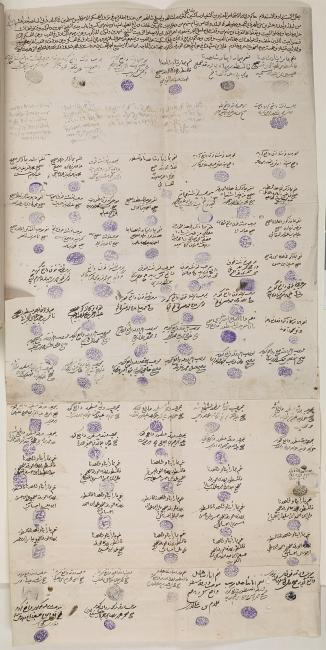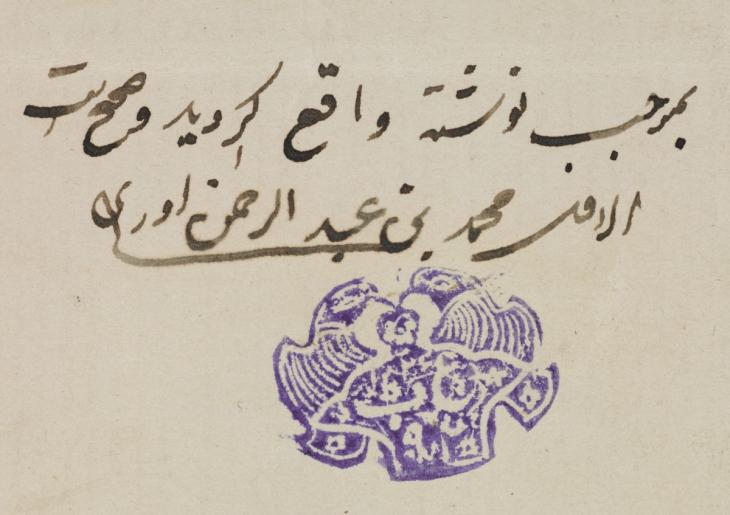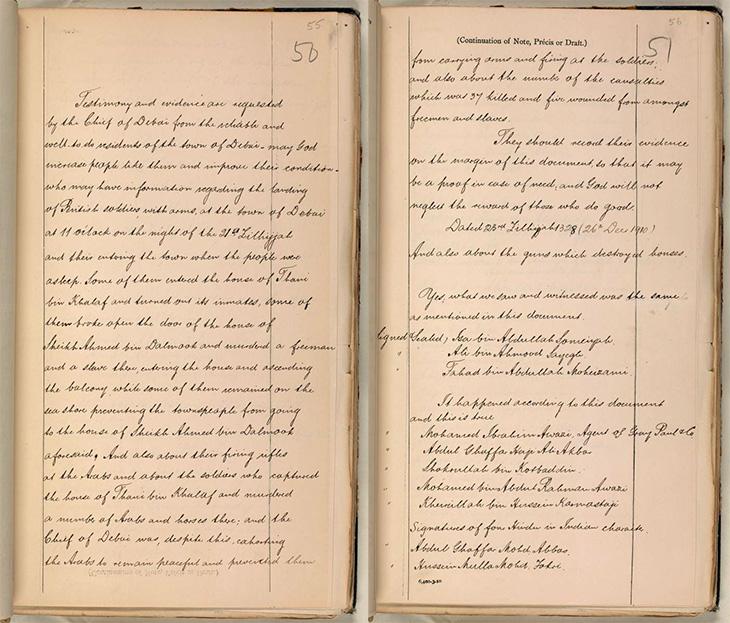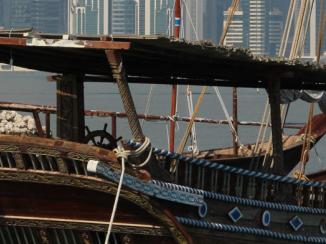Overview
At some point in the first few days of the new year 1911, the principal residents of Dubai came together to dictate their account of an incident that had occurred less than two weeks previously. A bloody gun battle between locals and a British landing party had left many dead.
The men, wishing to establish the veracity of the account, each impressed their personal seal below the account and individually signed and declared their agreement with it.

‘The Debai Incident’ of 1910
The gun battle, known as ‘The Debai Incident’, between local inhabitants and British forces was followed by extensive correspondence between the Sheikh of Dubai and the British Resident disputing responsibility for the incident. One such document, enclosed by the Sheikh and dated 5 December 1910 is the witness statement of the prominent residents in Dubai. It bears the impressions of an unusually large number of personal seals. Although the document is striking due to its size, the seals themselves also merit close examination in terms of their style and decoration.

Seals, Signatures and Thumb Prints
Seals, as well as signatures and thumb prints, were a common means of authentication at the time and there are many examples scattered throughout the India Office The department of the British Government to which the Government of India reported between 1858 and 1947. The successor to the Court of Directors. records.
Most seals took the form of a stamp, which would be carried around the neck of the owner in a small pouch. To use it the wearer would ink it, then press it onto the document concerned. Many seals contain Arabic letters representing the name of the seal bearer, as well as decorative patterns.
Two Birds
In amongst the various impressions on this witness statement, one seal in particular stands out by comparison to the others. Unlike other Islamic seals, which frequently feature a variety of geometric or abstract designs, and rather than the text or pictorial designs used in Western seals, this seal depicts two birds.

This unusual design features two identical, stylised birds – possibly doves – facing each other.
Underneath this decorative image are inscribed two letters, two numbers written as figures, and four numbers written as figures. The two Arabic letters in the inscription ع ب are not joined. As such, these letters may indicate the initials of the original owner.
The unusual bird design means that the seal is, in all likelihood, a relatively modern Islamic seal. This appears to be borne out by the numbers inscribed on the seal. The smaller, four digit number appears first and seems to be 1224 or possibly 1234. This might represent the year the seal was made. The Hijrī year 1224 and 1234 correspond to 1809–10 or 1818–19 respectively. The larger two-digit number below it is 92, which may indicate the Hijrī year 1292, or 1875–76 in the Gregorian calendar.
Declaration and Signature
The Arabic handwriting above each seal in the document is either a declaration and a signature or a declaration only (folio 60), presumably because the name inscribed in the seal was generally seen as a signature in any case.
Still, the names of all those signing the document were listed at the foot of the translated account, in English. It is clear that none of these are signatures as the list has been added in a single hand. Instead these were most likely added by the British official who translated the Sheikh’s reply and enclosed testimony to the British Resident.

The order of the names in the list appears to match the sequence in which the witnesses applied their seals and declarations to the document. This confirms that the seal with the unusual bird design belonged to one of ‘the reliable and well-to-do residents of the town of Debai’, Muḥammad bin ‘Abd al-Raḥmān Awazī (folios 55–56).
A Persian Connection?
‘Awazī’ may refer to ‘Avaz’ (Evaz) an area in Fars, Persia. Equally, the hand in which his declaration is written is nasta‘līq, used predominantly in Perso-Arabic script, which could imply a connection to this area.
Wherever he was from, the name of the owner, does not match the initials. Perhaps Awazī inherited the seal from a relative. He could have acquired it any number of different ways. Alas, there is no further information in the file about him or his fellow witnesses.
However, this unusual seal, along with the distinctive style of writing of its owner, especially when set alongside the seals and declarations of the other prominent residents of Dubai, paints a distinctive picture of the town at this time. Not only is Perso-Arabic and Arabic script evident, but also an unrecognisable script of South-East Asian origin. It’s clear that in 1910 Dubai was an increasingly cosmopolitan place with residents of various cultural origins living alongside one another.


